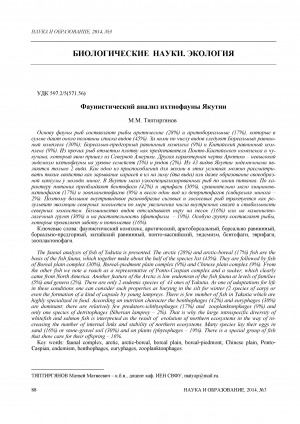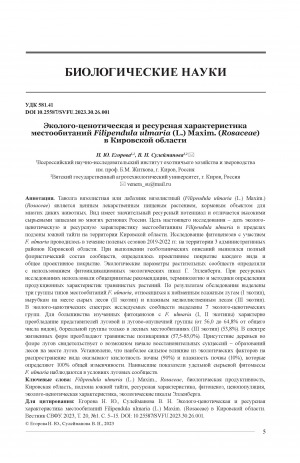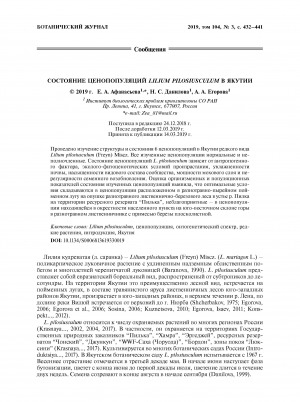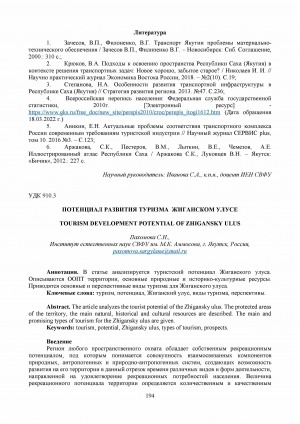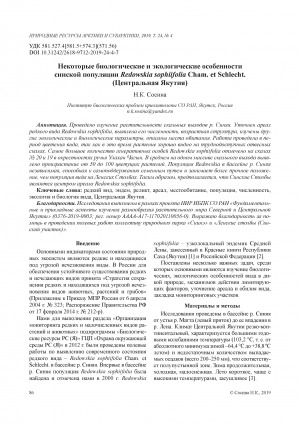Pyrola incarnatа - типичный бореальный вид, который широко распространен в таежной зоне. В Центральной Якутии часто выступает как содоминант в травяно-кустарничковом ярусе лиственничных лесов. По результатам анализа геоботанических описаний, сделанных по методу Браун-Бланке, все фитоценозы с участием P. incarnatа нами разделены на 4 ассоциации (асс. Saxifrago bronchialis-Pinetum sylvestris, асс. Limnado stelleri-Laricetum cajanderi, асс. Aquilegio parviflorae-Laricetum cajanderi и асс. Ledo palustris-Laricetum cajanderi), которые относятся к классу хвойных лесов Vaccinio-Piceetea Br.-Bl., Siss. et Vlieger 1939 [1]. В статье приведены данные по анализу экологических параметров и флористического анализа лесных сообществ с участием Pyrola incarnatа. Выявлены ведущие семейства и сопутствующие виды, которые участвуют в сложении фитоценоза вместе с P. incarnatа, зависимость состояния P. incarnatа от флористического состава фитоценозов. Оценка экологических предпочтений P. incarnatа осуществлена в соответствии с методом экологических шкал факторов увлажнения и богатства-засоленности. В результате анализа описаний нами установлено, что данный вид характеризуется широким варьированием устойчивости по условиям увлажнения, выбирает для произрастания участки от сухолугового до сыролугового типа увлажнения (ступени шкалы от 59,2 до 68,3), а по фактору богатства-засоленности предпочитает довольно богатые почвы (ступень от 8,2 до 11,5). При этом фитоценозы асс. Ledo palustris-Laricetum cajanderi, Limnado stelleri-Laricetum cajanderi и Saxifrago bronchialis-Pinetum sylvestris, четко распределились по градиентам богатства-засоленности и увлажнения, а сообщества асс. Aquilegio parviflorae - Laricetum cajanderi больше тяготеют к сухолуговым условиям и расположились полностью поверх показателей сообществ ассоциации Saxifrago bronchialis-Pinetum sylvestris, частично наложились на область показателей ассоциации Limnado stelleri-Laricetum cajanderi, при этом не касались области более влажных условий зоны распространения фитоценозов ассоциации Ledo palustris-Laricetum cajanderi.
Pyrola incarnata is a typical boreal species that is widespread in the taiga zone. In Central Yakutia, it often acts as a co-dominant in the herbaceous-shrub layer of larch forests. Based on the results of analysis of geobotanical descriptions according to the Brown-Blanke method, all phytocenoses with the participation of P. incarnata were divided into 4 associations (acc. Saxifrago bronchialis-Pinetum sylvestris, acc. Limnado stelleri-Laricetum cajanderi, acc. Aquilegio parviflorae-Laricetum cajanderi and acc. Ledo palustris-Laricetum cajanderi), which belong to the class of coniferous forests Vaccinio-Piceetea Br.-Bl., Siss. et Vlieger 1939 [1]. The article presents data on the analysis of environmental parameters and floristic analysis of forest communities with the participation of Pyrola incarnata. The leading families and related species involved in the formation of phytocenoses together with P. incarnata, the dependence of the state of P. incarnata on the floral composition of phytocenoses were identified. The identification of the ecological preferences of P. incarnata was carried out according to the method of environmental humidity indicators and richness factors-salinity. As a result of the studies conducted in the conditions of Central Yakutia, we have found out that the species is characterised by a relatively wide range of tolerance in terms of the moisture factor. It prefers growth sites from dry meadows to raw meadows type of moisture, stages from 59.2 to 68.3, and in terms of the richness-salinity prefers rather rich soils, stages from 8.2 to 11.5. At the same time, the phytocenoses of assoc. Ledo palustris-Laricetum cajanderi, Limnado stelleri-Laricetum cajanderi and Saxifrago bronchialis-Pinetum sylvestris were clearly distributed along the gradients of richness-salinity and moisture, and the communities of assoc.. Aquilegio parviflorae-Laricetum cajanderi tends towards dry meadow conditions and is located completely on top of the indicators of the communities of the association Saxifrago bronchialis-Pinetum sylvestris, and partially overlapping the area. The indicators of the Limnado stelleri-Laricetum cajanderi assoc. did not affect the area of wetter conditions, the zone of distribution of the phytocenoses of the Ledo palustris - Laricetum cajanderi assoc.


